Unlocking the Secrets of PLC Spare Parts: What You Didn't Know!
Unlocking the Secrets of PLC Spare Parts: What You Didn't Know!
In the world of industrial automation, Programmable Logic Controllers (PLCs) serve as the backbone of production systems, ensuring that processes run smoothly and efficiently. However, like any sophisticated piece of technology, PLCs require upkeep and, sometimes, replacement parts – known as PLC spare parts. These components are not just backup options; they are critical for maintaining the reliability and performance of PLC systems. In this article, we will delve into the different types of PLC spare parts, explore their functions, and provide insights on how to effectively manage them. Whether you’re an engineer, technician, or a curious enthusiast, understanding these components will enhance your knowledge and ability to maintain automated systems effectively.
Understanding PLC Spare Parts
PLC spare parts are components that can be replaced or repaired to keep a PLC system operational when parts fail or wear out. These spare parts are crucial for minimizing downtime in production environments, where even a short interruption can lead to significant financial losses. Common scenarios that necessitate the use of spare parts include equipment failure due to wear and tear, unexpected power surges, or environmental conditions that may degrade components over time. In my experience, a colleague once faced a major production halt because a vital PLC component failed unexpectedly. This incident underscored the necessity of having an inventory of spare parts on hand to prevent such disruptions. By understanding PLC spare parts, businesses can ensure their systems are always running at peak efficiency.
Types of PLC Spare Parts
There are several types of PLC spare parts available that cater to different functions within the system. Some of the most common categories include Input/Output Modules, Power Supply Units, and Processors or CPUs. Each of these components plays a vital role in the overall functionality of a PLC system. For instance, Input/Output modules act as the interface between the PLC and external devices, facilitating vital data communication. Similarly, power supply units ensure that the PLC receives the necessary electrical input to operate seamlessly. Understanding these parts not only helps in replacement but also in optimizing the performance of PLC systems.
Input/Output Modules
Input/Output (I/O) modules are essential components of PLC systems, responsible for interfacing with field devices such as sensors, actuators, and switches. They serve as the communication bridge between the PLC and the external environment. Input modules receive signals from field devices, converting the analog or digital signals into a format that the PLC can process. Conversely, output modules send signals from the PLC to the field devices, controlling the operation of machinery and other equipment. The effectiveness of an entire automation system depends heavily on the performance of these modules, making them a critical spare part to keep on hand.
Power Supply Units
Power Supply Units (PSUs) are another crucial spare part in any PLC system, converting the incoming electrical supply into a stable voltage that the PLC can use. They ensure that all components of the PLC receive the correct power, which is vital for maintaining performance and preventing damage. In my friend’s manufacturing plant, they experienced frequent power fluctuations that led to several PSU failures, causing interruptions in production. By investing in quality PSUs and maintaining a few as spares, they were able to reduce downtime significantly. Having a reliable power supply not only enhances the lifespan of the PLC but also ensures operational consistency.
Processors and CPUs
The Processor or Central Processing Unit (CPU) is often considered the brain of the PLC system. It is responsible for executing control instructions based on input signals and processing outputs accordingly. When replacing a CPU, it’s essential to consider factors such as compatibility with existing modules, processing speed, and memory capacity. A friend of mine once upgraded his facility’s PLC CPU to improve processing speed, leading to a noticeable increase in system efficiency. This experience highlights the importance of selecting the right CPU to match the demands of the specific application.
Functions of Different Spare Parts
Each type of PLC spare part serves a unique function that contributes to the overall efficiency and reliability of the PLC system. Input/Output modules facilitate data exchange between the PLC and field devices, enabling real-time monitoring and control. Power Supply Units are crucial for providing the necessary voltage levels, ensuring stable operation and protecting against power surges. Meanwhile, processors and CPUs execute complex algorithms and control logic, allowing for precise automation. By understanding these functions, technicians can better assess which spare parts need to be stocked based on the operational demands of their systems, ultimately leading to improved uptime and productivity.
Best Practices for Managing PLC Spare Parts
Effectively managing an inventory of PLC spare parts is essential for minimizing downtime and ensuring operational efficiency. Here are some best practices to consider: First, maintain an up-to-date inventory that includes details about each part, such as its function and compatibility. Second, establish a systematic approach for monitoring the condition of spare parts, especially those that are frequently used. Third, consider implementing a reorder point system to ensure that critical components are always available before they are needed. Lastly, training staff on the importance of these components and their management can lead to better preparedness and response times when issues arise. By adopting these practices, organizations can enhance their PLC system’s reliability and reduce the risks associated with unexpected failures.
Key Takeaways on Managing PLC Spare Parts
In conclusion, understanding PLC spare parts and their functions is crucial for anyone involved in industrial automation. From Input/Output modules to Power Supply Units and Processors, each component plays a vital role in ensuring that PLC systems operate efficiently and reliably. By staying informed about these parts and implementing effective management practices, organizations can minimize downtime and maximize productivity. Equip yourself with this knowledge and take proactive steps to manage your PLC systems effectively – it will pay off in the long run.
